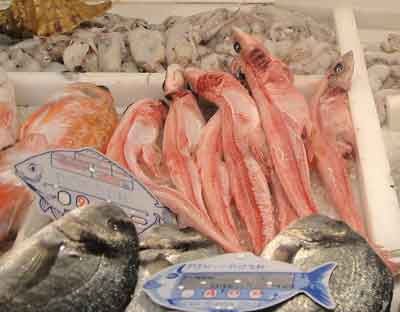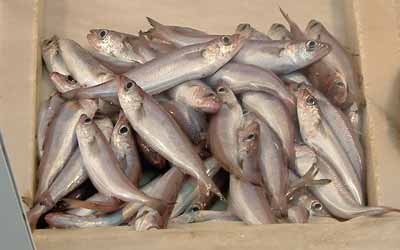
Huss. This species of dogfish has a grey-brown skin with quite pronounced dark spots. Because of its relative similarity to a shark the coarse skin is usually removed by fishmongers. These fish grow to about 80 cm (32 inches) in length. The flesh is white or pinkish with a firm texture and good flavour. It is boneless. It is also commonly known as the spotted dogfish or nursehound or, in some places, as rock salmon or rock eel. Spurdog, smoothound and tope are all sold as huss. It is an excellent addition to soups because of its texture. It feeds on shellfish which flavours its own firm, white flesh.

Big-scale atherine. A type of atherine similar to the sand smelt. A marine fish, usually deep-fried, it is a small, silvery fish similar to the argentine. When tiny it is treated in the same way as whitebait. This fish grows up to 12 cm.
Alose. Allis shad. A freshwater shad, from a family of white, migratory fish. The shad is a bony, tasty, oily fish similar to herring, which travels up rivers in spring and is found in deep lakes. In France it is found in the Gironde where it is often grilled over vine shoots or stuffed with sorrel, and in the Loire, where it may be stuffed with beurre blanc. The roe is a great delicacy and shad is also used raw in sushi. Members of the family include Allis shad (Alosa alosa) and the smaller twaite shad or gizzard shad (Alosa fallax).
The flesh of the lower jaw, ganglions that grow in the throat of the hake, greatly prized in the Basque Country, and shaped like an arrow-head. They sound almost like tonsils.
Greencracked brittlegill. A variety of wild mushroom which, as its name implies, is a sort of olive green with darker green markings and with creamy brittle gills. Most brittlegills resemble other ones that are inedible and some will cause gastric problems. You can normally detect what type it is by the flavour. A tiny tasting will immediately reveal whether or not it is edible, but it is worth spitting it out immediately if you detect a bitter taste.